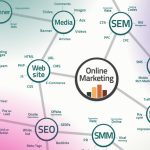Last Updated on 25th April 2023
 What do you think when you read typically-worded copy on a brand website? Is it not often the case that companies use business terms and corporate-sounding lingo?
What do you think when you read typically-worded copy on a brand website? Is it not often the case that companies use business terms and corporate-sounding lingo?
The language marketer’s use is designed to make them appear more business-like? Yes, we know you are a business, but readers are not. They may own a business, but they are actually human. And it is the human you are communicating with, not the business.
From a personal point of view, I have never liked corporate-lingo anyway. Why invent pretentious words when everyday language communicates a point better? Using business orientated expressions with work colleagues is laughable and unnecessary.
And it is also unnecessary online. It is especially unnecessary online! So in future, talk to the human, because the business ain’t listening!
How do you humanise your brand?
The inbound marketing age requires companies to develop interactive relationships and understand who their audience is, what their interests are and how you can fulfil their needs.
Online technologies such as virtual assistants and social media networks enable you to interact in real-time, learn more about your customers, listen to their needs and answer their questions.
All you have to do is communicate like you would if you are talking to the customer face-to-face. Conversations in real-time are much easier for marketers and sales staff to appear human. Just speak normally, no lingo needed.
The same principle should apply for your sales literature, emails, newsletters, website copy and blog content. By all means add emphasis to the point you are making, but do not overload a sentence with business words and phrases. Ultimately the sentence doesn’t make sense.
Communication should be simple and straight to the point. If readers do not understand what they have just read, you have not communicated with them. You have just given them something to read which they will do and then move on.
But you need them to act upon your words. And for them to do that they need to understand what you saying and what they need to do next.
Your ‘About Us’ Page should tell your story
So let’s start with the About Us page. This is your chance to introduce yourself to your customers and tell them about yourseld together with your company’s philosophies, goals and purpose.
Most About Us pages are boring aren’t they? The reason for this is because they focus on the company brand rather than the person who created the company brand. There is no story.
Your Abut Us page will be much more interesting and bonding if you tell the story of who you are as a person and how the idea for your company came into being. Which is much more interesting. A true story is also much easier to write!
Do not be afraid to be honest and heartfelt. If you have suffered trials and tribulations getting your business started, this can work in your favour. People love stories of determination which overcome adversity. It’s inspirational. It’s life – a very human experience.
You can also be humorous. You like to laugh right? Of course you do! And so do other people. Humans are much more responsive to people that make them laugh than when they use dry language. Tell your story in a professional way by all means, but keep it light-hearted.
Make an appearance
Consumers are more responsive to companies that include photographs of themselves and their team. Putting a face to a name makes your audience more receptive, increases their trust and improves your online creditability.
You should also include photographs of your staff, both a group photograph taken outside your offices, and working in their natural environment. It is not necessary to include this as part of any sales packaging, but this type of content should most certainly feature on your blog with a ‘meet the team’ link from your About Us page.
You can also use other human tricks to win people over such as poking fun at yourself, admitting your mistakes, and interact with your social media connections by commenting on their posts and status.
Humanising your brand is becoming more important now the mind set of consumers is changing. Online shopping still presents trust barriers for some consumers, and by appearing like a person rather than a faceless corporation you can help build bridges that cross the digital threshold from being business-like to being human.












